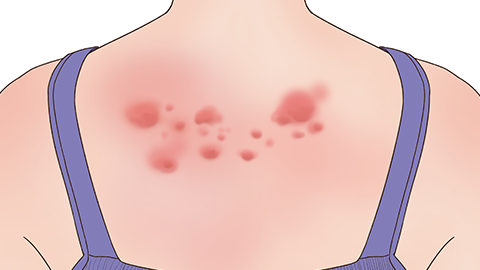What is the difference between the early stage of urticaria and a mosquito bite swelling?
Generally speaking, urticaria (hives) and mosquito bites represent two different types of skin reactions, differing in their causes, rash morphology, patterns of onset and resolution, itch characteristics, and distribution. If abnormal skin rashes accompanied by itching appear, it is recommended to evaluate the specific situation and seek professional help when necessary. A detailed analysis is as follows:
1. Causes
Early-stage urticaria is often caused by allergic reactions, such as exposure to allergens like pollen, foods, or medications, or may be triggered by temperature changes, emotional stress, and other factors. There is no definite bite mark. Mosquito bites, on the other hand, are localized reactions caused by substances in mosquito saliva after a bite. A clear puncture point is visible and closely related to mosquito activity.
2. Rash Morphology
Early urticaria lesions appear as wheals—irregularly shaped, variably sized, raised, pale red or white swellings with clear borders, which may appear isolated or merge into larger patches, with a smooth surface. Mosquito bites typically present as small, red, isolated papules (bumps), often with a pinpoint bite mark at the center, firmer in texture, and with relatively limited elevation.

3. Onset and Resolution Characteristics
Urticaria wheals appear suddenly and can develop rapidly in multiple areas of the body. They tend to resolve quickly, usually disappearing within hours without leaving a mark, although they may recur easily. Mosquito bites generally appear from several minutes to several hours after being bitten, and fade more slowly, typically lasting 1–3 days. After resolution, temporary pigmentation may remain.
4. Itching Characteristics
Itching in early urticaria is intense, often worsening with the appearance of wheals, and may affect a wide area. Mosquito bites cause relatively milder, localized, intermittent itching, which may temporarily worsen with scratching but is generally limited to the bite site and its immediate surrounding area.
5. Distribution Patterns
Urticaria wheals may appear on any part of the body, including the trunk, limbs, and face, with no fixed location, and may change over time. Mosquito bites commonly occur on exposed areas such as the limbs, face, and neck—consistent with areas easily bitten by mosquitoes—and are relatively scattered in distribution.
In daily life, it is important to take measures to prevent mosquito bites and avoid areas with high mosquito density. If a rash accompanied by itching appears on the skin, observe whether there are bite marks and the pattern of onset. Avoid excessive scratching. If the rash is widespread, itching is severe, or symptoms recur frequently, it may indicate urticaria, and prompt medical consultation is advised for accurate diagnosis and treatment as directed by a physician. Self-medication should be avoided.




